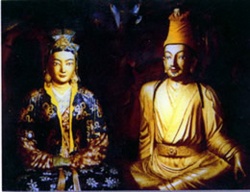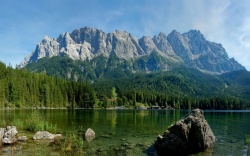The Japanese Buddhist Schools
Zen School of Dhyana.
Collectedness of mind or meditative absorption in which all dualistic distinctions like I/you, subject/object, and true/false are eliminated. There are two major branches in this school : Soto and Rinzai.
Amidism
School of Pure land (Sukhavati)
Through faithful devotion to Amitabha and through recitation of his name, one can be reborn there and lead a blissful like until entering final nirvana. There are two major branches in this school : Jodo-Shu and Jodo-ShinShu.
Ritsu School of Discipline (Vinaya).
It contains the rules and regulations for the communal life of monks and nuns.
Shingon School of Secrets. Tantric School.
The important elements of the practice of this school are the recitation of mantras, the use of mudras and mandalas, and of empowerment cermonies.
The objective of the practice is to obtain the sense of harnessing oneself to Buddha, seeking union with him.
Tendai School of Tien-Tai (Saddharmapundari).
"School of the Celestial Platform."
The school takes as a premise that all phenomena are an expression of the absolute, of "suchness" and this is expressed in the teaching of three truths: empty, delusion, middle.
Kegon School of Flower Garland (Hua-Yen) (Avatamsa).
The teaching is known as the "teaching of totality". The center of the teaching is the equality of all things and the dependence of all things on tone another.
Hosso School of Mind Only (Fa-Hsiang) (Cittamatra).
The school takes as a premise that all thing are of mind-evolution, and are neither in themselves real nor unreal.
Sanron
School of Three Sastra (Madhyamika).
The teaching of the middle way. It refrains from choosing between opposing positions, and in relation to the existence or nonexistence of all things, treads a middle way.
Nichiren School of Nichiren.

